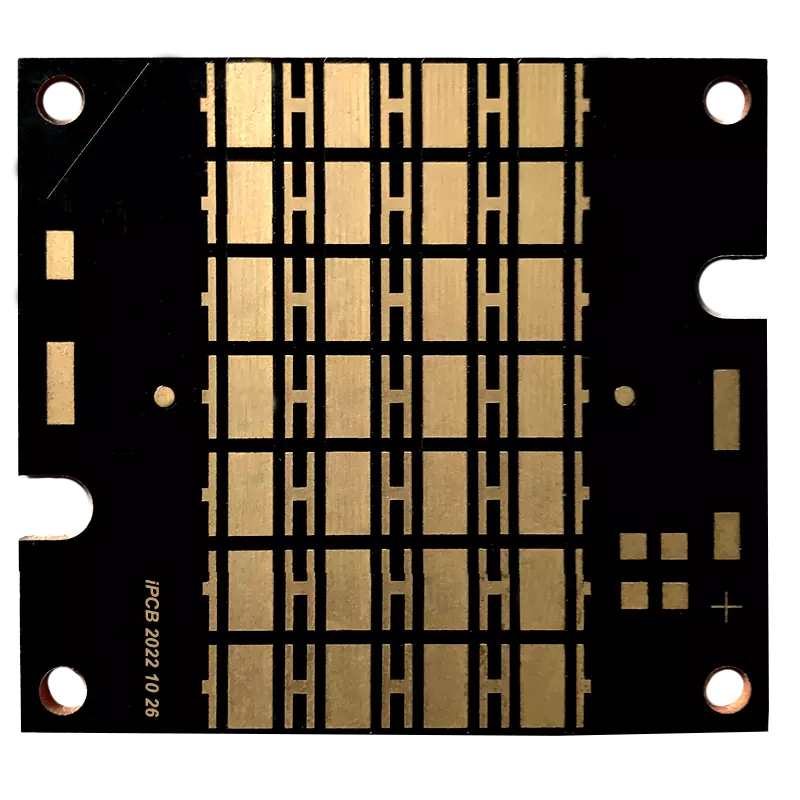
Product: Copper PCB
Material: copper substrate
Layer: 1
Color: Black
Finished thickness: 2.0mm
Copper thickness: 3oz
Surface treatment: ENIG
Minimum line width: 12mil
Minimum spacing: 12mil
Thermal conductivity: 3W/mK
Application: High power component
What is Copper PCB? Copper PCB is the most expensive and has the best thermal conductivity among metal bonds. Its metal layer is composed of copper plates with high thermal conductivity, which can carry higher currents. Its thermal conductivity is twice that of aluminum PCB, making it suitable for high-frequency circuits, applications with large temperature changes, and heat dissipation of precision communication equipment.
Copper PCB has extremely high heat dissipation performance and can be processed into metalized holes, increasing its application flexibility.
The difference between Copper PCB and Aluminum PCB
In the field of electronic manufacturing, especially LED PCB, the selection of circuit board materials is crucial. Copper PCB and aluminum PCB are two common choices, each with unique advantages and applicable scenarios. So what is the difference between Copper PCB and Aluminum PCB?
1. Differences in material properties between Copper PCB and Aluminum PCB
Copper PCB: Copper PCB is mainly made of copper, which has good conductivity and thermal conductivity. This makes Copper PCB perform well in situations that require efficient heat dissipation and stable electrical performance. The stability and corrosion resistance of copper also ensure the reliability of the substrate in complex environments.
Aluminum PCB: Aluminum PCB is based on aluminum, which has low density, light weight, and good thermal conductivity. Although aluminum's conductivity is not as good as copper, in some applications with strict weight requirements, such as the aerospace industry, aluminum PCB is a more suitable choice.
2. Differences in heat dissipation performance between Copper PCB and Aluminum PCB
Copper PCB: Due to the high thermal conductivity of copper, copper PCB has significant advantages in heat dissipation. In high power density electronic devices such as power modules, LED lighting, etc., Copper PCB can effectively conduct heat from the heat source to the heat sink, keeping the device within a safe operating temperature range.
Aluminum PCB: Although aluminum has a lower thermal conductivity than copper, aluminum PCB still performs well in heat dissipation. Especially in some applications with medium power density, aluminum PCB provides sufficient heat dissipation capacity, while its lower cost and weight make it an economical and practical choice.
3. Differences in Composition between Copper PCB and Aluminum PCB
Copper PCB: Due to the relatively high price of copper and slightly higher processing difficulty, the overall cost of copper PCB is usually higher than that of aluminum PCB. This may make Copper PCB less preferred in some cost sensitive projects.
Aluminum PCB: Due to its lower material cost and relatively easy processing, aluminum PCB has an advantage in cost control. In projects that seek a balance between performance and cost, aluminum PCBs are often the more popular choice.
4. Application differences between Copper PCB and Aluminum PCB
Copper PCB: Copper PCB is widely used in high-performance electronic devices, automotive electronics, industrial automation and other fields due to its excellent heat dissipation performance and electrical stability. Especially in situations that require long-term stable operation and high heat dissipation requirements, Copper PCB is indispensable.
Aluminum PCB: Aluminum PCB is widely used in LED lighting, consumer electronics, communication equipment and other fields due to its excellent heat dissipation performance and cost advantages. The lightweight and corrosion resistance of aluminum PCB also make it a popular choice in outdoor and harsh electronic devices.
5. Differences in Manufacturing Processes between Copper PCB and Aluminum PCB
Aluminum PCB: Aluminum PCB processing is relatively easy, and commonly used processing methods include laser cutting, drilling, composite, etc.
Copper PCB: Processing copper PCB is relatively more difficult. To carry out processes such as circuit cutting, advanced technology and equipment are required. However, the difficulties in processing have also provided Copper PCB with a wider range of applications in certain fields.
Copper PCB and aluminum PCB have significant differences in material properties, heat dissipation performance, cost, and application scenarios. When selecting substrate materials, it is necessary to comprehensively consider the specific needs and budget of the project.
Product: Copper PCB
Material: copper substrate
Layer: 1
Color: Black
Finished thickness: 2.0mm
Copper thickness: 3oz
Surface treatment: ENIG
Minimum line width: 12mil
Minimum spacing: 12mil
Thermal conductivity: 3W/mK
Application: High power component
iPCB Circuit provides support for PCB design, PCB technology, and PCBA assembly. You can request technical consultation or quotation for PCB and PCBA here, please contact email: sales@ipcb.com
We will respond very quickly.